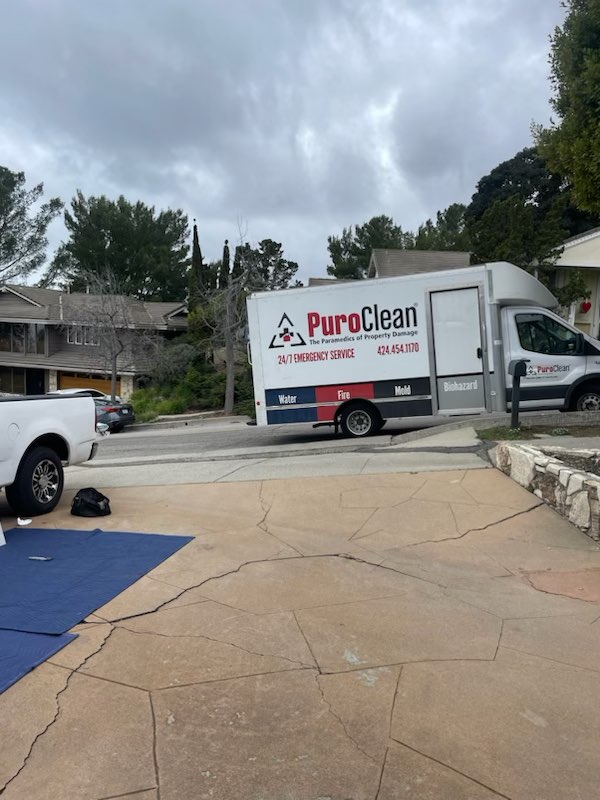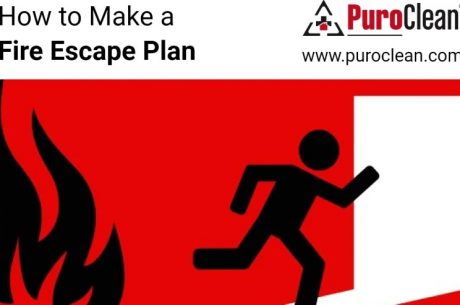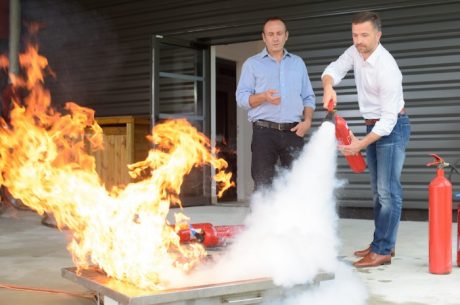Kitchens are a common place for cooking fires to start, potentially leading to a house fire. When preparing food, you may be working with exposed flames or very high heat with your appliances, such as a toaster. For this reason, you should take preventive measures when cooking meals to prevent kitchen fires, as recommended by the National Fire Protection Association. Below are some kitchen fire safety tips that you can do to add to your safety in the kitchen, along with what to do after a small kitchen fire takes place.

The aroma of a delicious meal, the sizzle of a pan, the warmth of a bustling kitchen – it’s the heart of many West Los Angeles homes. But beneath the surface of culinary delight lies a silent threat: kitchen fires. These incidents are, unfortunately, the leading cause of home fires and injuries across the nation, and our vibrant West LA community is no exception. At PuroClean of West Los Angeles, we see firsthand the devastation these fires can cause, and we’re committed to helping you understand how to prevent them and, crucially, what to do if the unthinkable happens.
Read Also: How to Find Air Leaks in Your West LA House in 2025
This comprehensive guide will arm you with the knowledge and actionable steps to keep your West Los Angeles kitchen safe, minimize damage if a fire occurs, and navigate the aftermath with confidence.
The Alarming Reality: Why Kitchens are Fire Hotspots
It’s easy to get comfortable in our daily routines, and cooking is one of the most routine activities we undertake. However, this familiarity can breed a dangerous complacency. The National Fire Protection Association (NFPA) consistently reports that cooking is the leading cause of home fires and home fire injuries, and the second leading cause of home fire deaths. In fact, ranges or cooktops are involved in over half of reported home cooking fires.
Why are kitchens so prone to fires? Several factors contribute:
- Unattended Cooking: This is by far the biggest culprit. A momentary distraction – a phone call, a doorbell, a child’s cry – can turn a simmering pot into a raging inferno in seconds.
- Grease Fires: Hot cooking oils and fats have a low flash point, meaning they can ignite quickly and intensely. Water should never be used on a grease fire, as it can cause the burning oil to splatter, spreading the fire rapidly and dangerously.
- Combustible Materials: Oven mitts, dish towels, paper towels, food packaging, and curtains often sit too close to burners or ovens, providing ready fuel for a stray spark or flame.
- Overheating Appliances: Faulty wiring, dirty appliances (like toasters with accumulated crumbs, or ovens with built-up grease), and even leaving small appliances plugged in can lead to overheating and ignition.
- Human Error: From forgetting to turn off a burner to improperly handling flammable liquids, simple mistakes can have severe consequences.
- Age-Related Risk: Studies show that individuals 55 years of age and older, particularly those 85 and older, are at a significantly higher risk of cooking fire deaths. This underscores the importance of extra precautions and support for our senior community members.
Understanding these common causes is the first step toward proactive prevention.
Prevention is Key: Making Your West LA Kitchen Fire-Safe
While accidents can happen, a vast majority of kitchen fires are preventable. By implementing these simple yet crucial precautions, you can significantly reduce the risk in your West Los Angeles home:
- Never Leave Cooking Unattended: This cannot be stressed enough. If you’re frying, grilling, or broiling, stay in the kitchen. If you must leave the room, even for a moment, turn off the stove. For simmering, baking, or roasting, set a timer to remind yourself to check on your food regularly.
- Keep Your Cooking Area Clear: Maintain at least a three-foot clear zone around your stove and oven. Remove anything that can catch fire – oven mitts, wooden utensils, food packaging, towels, curtains, and even recipe books.
- Cleanliness is Crucial: Regularly clean your stovetop, oven, and exhaust hood to prevent grease and food particle buildup. These residues are highly flammable.
- Dress for Success (and Safety): Avoid wearing loose-fitting clothing with long, dangling sleeves when cooking, as they can easily catch fire or snag on pot handles.
- Turn Pot Handles Inward: This simple habit prevents accidental knocking and spills, especially important if you have children or pets in the home.
- Know Your Oils’ Smoke Points: Different cooking oils have different smoke points (the temperature at which they begin to smoke). Heating oil past its smoke point not only degrades the oil but also significantly increases the risk of a grease fire.
- Invest in a Fire Extinguisher (and Know How to Use It!): A Class K or wet chemical extinguisher is specifically designed for cooking oil fires. A multi-purpose ABC extinguisher can also be effective for other types of kitchen fires (wood, paper, electrical). Keep it easily accessible, know its type, and familiarize yourself with the PASS method (Pull, Aim, Squeeze, Sweep) of operation.
- Install and Test Smoke Alarms: Ensure you have working smoke alarms on every level of your home, including one in or near the kitchen (but not so close that it triggers false alarms from cooking fumes). Test them monthly and replace batteries at least once a year.
- Educate Your Household: Everyone in your home, especially children, should understand kitchen safety rules and what to do in case of a fire.
- Regular Appliance Maintenance: Inspect appliance cords for fraying or damage. If an appliance is acting unusual (e.g., hot to the touch, flickering lights), unplug it and have it professionally serviced or replaced.
By adopting these practices, you’re not just preventing fires; you’re cultivating a safer environment for your entire family in West Los Angeles.
When the Unthinkable Happens: What to Do in a Kitchen Fire
Despite our best efforts, fires can still occur. Knowing how to react quickly and calmly is paramount to ensuring safety and minimizing damage.
Immediate Action: Prioritize Safety Above All Else
- Alert Everyone and Evacuate: As soon as you detect a fire, shout “Fire!” to alert everyone in the house. Ensure all occupants, including children and pets, evacuate the premises immediately. Never prioritize belongings over human lives.
- Call 911: Once everyone is safely outside, call 911. Provide accurate information about your address and the situation. Stay calm and answer any questions the dispatcher may have.
If the Fire is Small and Contained (and Only If It’s Safe to Do So):
Different types of kitchen fires require different responses. Crucially, if you are unsure, if the fire is spreading, or if you feel unsafe, evacuate immediately and call 911.
- Grease Fire (on the stovetop):
- DO NOT USE WATER! Water will cause the burning oil to splatter and spread.
- Turn off the heat source immediately.
- Smother the flames: If it’s safe to do so, carefully slide a lid over the burning pan to cut off the oxygen supply. Leave the lid in place until the pan has completely cooled.
- Use baking soda: For very small grease fires, a generous amount of baking soda can sometimes help smother the flames by releasing carbon dioxide.
- Use a Class K or Wet Chemical Extinguisher: If available and you are trained, aim at the base of the fire and sweep.
- Never try to carry the burning pan outside. This often results in severe burns and the spread of fire.
- Oven Fire:
- Turn off the oven immediately.
- Keep the oven door closed. This will contain the fire and cut off its oxygen supply, allowing it to burn itself out.
- If the fire does not extinguish on its own, and it’s safe to do so, use an ABC or Class K fire extinguisher through a vent or from a safe distance.
- If it continues to burn or fills your home with smoke, evacuate and call 911.
- Microwave Fire:
- Unplug the microwave immediately.
- Keep the microwave door closed. This will usually contain the fire and cut off oxygen.
- If the fire persists, evacuate and call 911. Do not open the door until the fire is completely out and the microwave has cooled.
Read Also: How to Make a Fire Escape Plan in Los Angeles
If the Fire is Large, Spreading, or You Are Unsure:
- Evacuate immediately.
- Close doors behind you if possible. This can help to contain the fire and slow its spread, protecting other areas of your home.
- Do not re-enter the house for any reason. Wait for the fire department to arrive and deem it safe.
After the Smoke Clears: The Road to Recovery
Even a small kitchen fire can leave behind significant damage – not just from flames, but from smoke, soot, and the water used to extinguish the fire. The emotional toll can also be substantial. This is where professional restoration services become invaluable.
Initial Steps After a Fire:
- Do Not Re-Enter Without Permission: The fire department will tell you when it’s safe to re-enter your home. There may be hidden hazards, structural damage, or lingering fumes.
- Contact Your Insurance Company: Notify your insurance provider as soon as possible. They will guide you through the claims process. Document everything with photos and videos before any cleanup begins.
- Resist the Urge to Clean Immediately: While it’s natural to want to start cleaning, fire and smoke damage requires specialized knowledge and equipment. Improper cleaning can spread soot and smoke particles, making the damage worse and harder to remove.
- Prioritize Your Health and Safety:
- Wear protective gear (gloves, N95 mask) if you must briefly enter the affected area.
- Avoid consuming any food or drinks that may have been exposed to smoke or fire.
- Open windows and doors to ventilate, but avoid creating drafts that could spread soot.
PuroClean of West Los Angeles: Your Partner in Restoration
When a kitchen fire disrupts your West Los Angeles home, you need a trusted partner to help you navigate the complex path to recovery. PuroClean of West Los Angeles is precisely that partner. We specialize in comprehensive fire and smoke damage restoration, offering 24/7 emergency services to respond swiftly to your needs.
Our highly trained and certified technicians understand the unique challenges posed by kitchen fires, including:
- Soot and Smoke Removal: We use specialized equipment and techniques to effectively remove soot and smoke residue from all surfaces, including walls, ceilings, cabinets, and appliances.
- Smoke Odor Elimination: Lingering smoke odors can be persistent and pervasive. Our advanced deodorization methods, including ozone generators and hydroxyl generators, neutralize odors, leaving your home fresh and clean.
- Contents Cleaning and Pack-Outs: We carefully assess, clean, and restore salvageable personal belongings, often packing them out to our facility for thorough cleaning and storage while your home is being repaired.
- Structural Cleaning and Repair: From initial assessment to structural support and board-ups, we handle all aspects of fire damage, including water damage from extinguishing efforts. We work to return your property to its pre-loss condition.
- Debris Removal and Sanitation: We safely remove all damaged materials and thoroughly sanitize the affected areas to ensure a healthy living environment.
- Insurance Claim Assistance: We can work directly with your insurance company, helping to document the damage, prepare necessary paperwork, and streamline the claims process, alleviating much of the stress for you.
A kitchen fire is a traumatic event, but with the right preparation and the support of experienced professionals, your West Los Angeles home can be fully restored. By prioritizing prevention and knowing the proper steps to take in an emergency, you’re investing in the safety and well-being of your family.

Don’t let a kitchen fire turn your life upside down. Be prepared, stay safe, and remember that PuroClean of West Los Angeles is always here to help you restore peace of mind and your home. Contact us at (424) 454-1170 for immediate assistance or for more information on our services.




 PuroClean of West Los Angeles
PuroClean of West Los Angeles